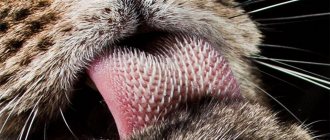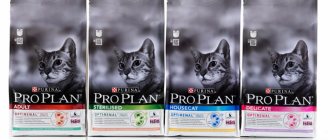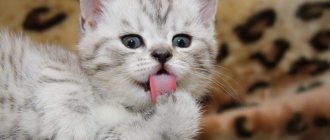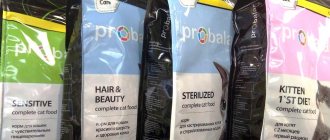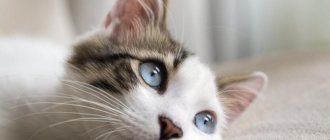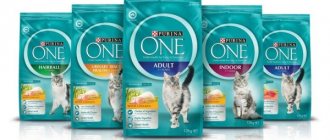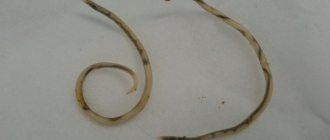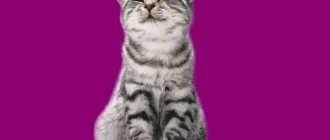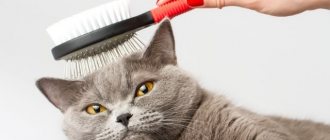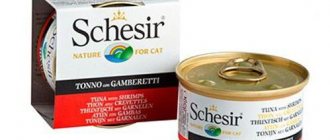Cats are decorations for any home. Graceful, purring and loving pets: what could be better? They are affectionate, beautiful, and it is impossible to take your eyes off their magnificent fur coat. But it is the cat’s fur that can cause many problems for its owner.
The fluffier the cat, the more hairs she sheds daily. This is an absolutely normal phenomenon associated with the life of an animal. However, this harmless process can cause a number of difficulties. The most common of these is the accumulation of hairballs in the animal’s stomach.
The dangers of hairballs in the stomach
Due to the peculiarities of the anatomical structure of the tongue (it is covered with small sharp papillae directed into the larynx), the cat cannot spit out dead guard hairs, so the hair inevitably ends up in the stomach. Due to the inability to be digested by gastric juice, it forms dense balls (trichobezoars) and clogs the gastrointestinal tract. Veterinarians call this phenomenon “gastric trichobezoar.” If not treated promptly, it can lead to the following complications:
- anorexia due to a false feeling of satiety;
- obstruction of the small intestine;
- constipation;
- disruption of the digestive process;
- pain in the gastrointestinal tract;
- ingrowth of villi into the mucous tissues of the oral cavity;
- inflammatory processes.
Due to the presence of trichobezoars in the stomach, the cat experiences constant discomfort. She will independently try to free herself from the foreign body by vomiting, but due to severe blockage, only liquid will come out. If you do not help your pet in time, surgical intervention is inevitable.
It is noteworthy that indoor cats do not have problems with the formation of trichobezoars in the stomach, since they lead an active lifestyle and have the opportunity to eat fresh grass, which improves the transit of fur through the gastrointestinal tract.
Gastric trichobezoars are most susceptible to:
- long-haired cats (Maine Coon, Persian, Siberian, etc.);
- older cats;
- animals that are obese or lead a sedentary lifestyle;
- cats with any type of coat (with the exception of hairless sphinxes, bambinos, elves, etc.) during the molting period.
Long-haired cats are most susceptible to gastric trichobezoar.
Personally, for the purpose of prevention, I always give my cat special homemade grass (it is sold in pet stores). It is a natural remedy for cleansing, contains minerals, amino acids, B vitamins, which not only improve digestion, but also have a beneficial effect on the appearance of the pet.
Wheat germ is the best remedy for preventing the formation of hairballs
Grooming
An adult cat in good health cleans its own fur, sometimes licking itself for several hours a day. However, the owner’s task is to help her get rid of fallen hairs and emerging impurities. This will require brushing and bathing procedures.
Combing helps solve 3 problems at once:
- Improve skin blood circulation and coat appearance.
- Prevent the formation of tangles - matted dense lumps of hairs that have fallen out and become entangled in the fur.
- Relieve your cat from having to swallow and then excrete a large amount of hair.
The frequency of the procedure depends on the breed.
- Short-haired cats with or without undercoat (Abyssinian, Siamese, Burmese, British) are brushed several times a week using brushes or a special mitten.
- Long-haired cats are combed daily or once every 2 days, devoting up to 1 hour to the procedure. At the end, the wool is lightly fluffed with a brush, and combed upward on the neck to form a beautiful collar.
For combing, you need brushes with natural bristles or slicker brushes, combs with sparse, non-sharp teeth, tangle cutters (if necessary), a “stroker” - a wide flat brush for combing the tail of long-haired cats, a special mitten, a piece of silk or suede. Combs are used as the tooth frequency increases. That is, you need to start the procedure with a sparse comb and end with a thick brush.
First, the sides, neck and back are combed, then the “pants”, belly, and tail. Finally, you can pet the cat with hands moistened with water to collect any remaining uncombed hairs. Short-haired cats can also be wiped with a piece of silk or suede cloth - this will add shine to your pet's coat.
You should wash your cat as needed, taking into account the characteristics of the breed. For example, hairless cats are washed once every 1-2 weeks, while smooth-haired cats can be bathed once every six months during shedding. For the procedure you will need:
- towel;
- basin with warm water. Some owners prefer to bathe their cat in a bathtub or sink;
- shampoo for cats.
It is better to choose shampoos from professional series adapted for home use. For example, “Elite” for deep cleaning of wool. The product combines a mild detergent complex and an exclusive composition of amino acids, vitamins, proteins and natural plant extracts. The shampoo gently but thoroughly cleanses the coat, makes it easier to comb, helps prevent dandruff, brittleness and tangling of the coat, and adds shine and silkiness.
When swimming, follow a few rules.
- The water should be at a comfortable temperature for the cat (36–38 °C).
- Bathing is carried out before meals or no earlier than 4 hours after meals.
- You don't need to immediately put your cat in a basin or bathtub of water, because it may get scared. It is better to wet the wool gradually from the ladle.
- Rinse off the shampoo thoroughly.
- While washing, talk to your pet in a gentle and encouraging voice and stroke it.
- Keep shampoo and water away from your cat's eyes, ears, nose and mouth.
- When drying wool, do not allow the temperature in the room to drop or drafts.
When should you give your cat hair-removing food?
The following symptoms indicate the presence of hairballs in your pet's stomach at an early stage:
- anxiety, nervous excitement;
- mucus in undigested food or stool;
- nausea, vomiting;
- constipation or diarrhea;
- dry cough;
- the coat becomes oily and dull.
In the case of severe blockage of the gastrointestinal tract, the cat experiences frequent vomiting (without hair, but with blood), a complete absence of stool for a long time (despite the animal’s unsuccessful attempts to relieve itself), as well as refusal to eat. At the same time, it cannot be said that the pet has no appetite: on the contrary, he begs for food, but cannot handle even the minimum portion. This is due to the fact that the cat does not receive the required amount of nutrients due to a feeling of false satiety. If such symptoms are present, the owner must urgently begin treatment.
Rules of use
Special food for hair removal is enriched with essential vitamins and minerals, has the correct BJU ratio, and is therefore complete. If symptoms occur that indicate the presence of trichobezoars in the stomach, the cat must be completely switched to “medicinal” food and fed until the problem disappears.
Before use, be sure to read the information on the packaging: the manufacturer gives clear instructions and recommendations. The average daily intake is 15–20 grams per 1 kg of animal weight. If desired, the portion can be increased (the cat can eat as much as it is used to). Usually the course lasts about a month. The first positive changes are observed within the first week. For preventive purposes, food can be given 1-2 times a month.
My cat, although he ate store-bought canned cat food, flatly refused special food. It was possible to remove the hairballs with the help of a cleansing paste, which he absorbed with particular pleasure. Each pet's tastes are individual, so the owner will have to find a suitable remedy through trial and error. If the cat refuses to eat one food, I recommend trying to purchase 1-2 more products from different manufacturers. Surely there will be food from them that the fluffy will like.
Castration and sterilization
Many owners are unsure whether to sterilize their pet. If you don’t want to see the “offspring” regularly, it’s better to do this procedure.
If you castrate a male, he becomes less excitable and aggressive, does not fight with rivals, does not look for a female, and does not leave the house. The risk of death under the wheels of a car disappears. The operation eliminates the habit of marking the premises in which people live with urine with a strong odor, which is undoubtedly liked by all owners.
When it comes to hair loss, veterinarians say that surgery and baldness are not directly related. However, castration for a cat is very stressful and even against this background, he may become somewhat bald. There's no need to worry. Gradually, the emotional state will be restored and the cat will become fluffy again.
A cat, as a predator, will never show that it is in pain or that it is not feeling well. Nature forces them to hide and suffer alone. Therefore, if you notice a difference in the appearance of your pet’s skin, you should contact your veterinarian.
Product composition
Hair removers contain several types of insoluble fiber that soften lumps and accelerate their transit through the gastrointestinal tract. Natural plant components (plantain seeds, flax) and oils envelop the walls of the stomach (serve as something like a lubricant), which allows trichobezoars to freely leave the pet’s body. The presence of vitamins and minerals helps normalize digestion and has a beneficial effect on the quality of the coat: it becomes shiny, smooth, and does not shed as much.
Hair-reducing food is suitable for animals that mainly eat ready-made store-bought products (canned food for cats, dry and wet food, etc.). Such cats practically do not feel the difference between new and old food, and therefore calmly accept “medicinal” food. This option is not suitable for pets whose diet consists of natural products. To remove hair, it is recommended to give them special cleaning pastes (Beafar, Cliny, Gimpet Malt-Soft Extra, Beafar). The principle of action and composition of such products are similar to hair removal feeds.
How to choose the right vitamins?
So, you noticed that your cat's hair is shedding a lot. What to do? If you are sure that the pussy is healthy and there is no reason to visit the veterinarian, you can simply buy a special vitamin complex. The choice will depend on several factors:
- age of the cat (vitamins are different for kittens and old cats);
- presence of pregnancy;
- preservation of the ability to reproduce (castrated and sterilized animals need a special complex);
- release form of the drug (gel, tablets, drops, paste);
- availability of a product certificate.
Vitamins and folk remedies for cats, their importance and need for use
Every loving and caring owner wants his pet to be happy and healthy. And for this you need to know about the important vitamins for the animal’s body and be able to use them.
Vitamins are a group of organic substances with the help of which all vital processes take place in the body. They increase resistance to disease and support immunity.
Although cats, compared to humans, are naturally endowed with greater resistance to disease, in certain situations their body’s protective functions are weakened. And then vitamins come to the rescue, as well as folk remedies that keep pets in good spirits, playful mood and shiny fur.
Vitamin A (increases immunity), B 1 (provides activity), B 2 (prevents baldness), B 6 (helps digest proteins and fats), E (antioxidant), C (increases resistance to infections) and a lot others.
Without tests and examinations, it is difficult to say which vitamin is more important. If necessary, this can be determined by a veterinarian. He can also prescribe the necessary complex of vitamins for your pet and indicate the exact dosage. The latter is important, because uncontrolled consumption of vitamins by animals can be harmful. Don’t forget about time-tested folk remedies. If a cat has the opportunity to be in nature, she is able to independently find useful fresh vegetation for herself. And if the animal does not leave the apartment, then the owner is obliged to take care of it.
The animal must be provided with sunlight, which ensures the production of vitamin D in the body.
Plants should be planted in pots on windowsills for the health of cats. Some diseases can be treated with the help of herbs, decoctions and lotions.
Errors in selection
Each cat is individual, so it is better to show it to the veterinarian periodically. By showing your pet to the doctor, he will be able to tell you exactly which product is suitable for him. There is quite a variety of cat food, so it’s easy to make a wrong choice. You need to select a product based on age, activity and coat type. If you give your cat professional food, it is undesirable to feed the animal additional vitamins, as this can cause an overdose and the hair will begin to fall out.
Sometimes there is no need to panic because of bad fur - in some cases, you just need to wash the cat with a good shampoo, and then use a spray to remove the faded fur. When feeding a cat, it is not advisable to mix natural food with food. Such mixing harms the animal's digestion. With frequent changes in the type of feeding, the stomach does not have time to adapt, so the work of the digestive system becomes more complicated.
When you change your diet, a number of problems appear - coprostasis, gastroenteritis and other dangerous conditions. In addition, mixing introduces an imbalance into the body.
Is there any harm from a dry menu: opinions of veterinarians
Each owner decides which food to choose independently. However, in order to make the right decision in feeding, many owners of four-legged animals are also interested in reviews from veterinarians. According to many veterinarians, feeding cats dry food is beneficial. The thing is that the finished food has a balanced composition. Long-haired or short-haired pets will not only be healthy, but the owner will also spend less money on dry food.
Also, such cat food stores well and has moderate consumption due to the low water content in the product. In reviews, veterinarians also note disadvantages. Thus, dry food is not as appetizing as natural or canned food. But by adding water to it, it will become more attractive to your pet. The reviews also provide a recipe for such a process.
The reviews also list another disadvantage of dry feeding. It lies in the fact that such food contains only dry ingredients, which impair digestibility. In the production of feed, meat flour and other components that have been processed are used. Violation of the drying regime, in turn, greatly reduces the amount of nutrients. However, among dry cat food, there are also those for the production of which various fresh meat ingredients are used.
Due to this, the feed granules contain a larger amount of fats and proteins with high biological value. Also, according to veterinarians, today there are no feeds on the Russian market that would be perfectly balanced. Almost all of them contain a lot of carbons, most of them have a high glycemic index. Many feeds, even those of the super premium class, exceed the carbon standard by forty percent. In a pet, exceeding this norm can lead to unwanted fluctuations in blood glucose levels, and other health problems are possible.
Ontario
Another representative of Czech production, whose assortment includes dry and wet rations. In the Ontario line you can choose food for:
- kittens, pregnant and lactating cats;
- adult animals;
- neutered pets;
- older animals.
The main source of protein in Ontario products is meat ingredients; there is no vegetable protein. Among the standard components for the premium class are also brewer's yeast, dried apples, a vitamin complex, and Yucca Schidigera extract.
However, the manufacturer indicates the sources of many product components only in general terms (for example, chicken products, poultry fat, antioxidants approved in the EU). Another disadvantage may be the pronounced smell of dry granules.
A two-kilogram package of Ontario dry food will cost from 650 rubles. As a supplement to the diet, you can choose canned food, of which there are 5 types in total.
